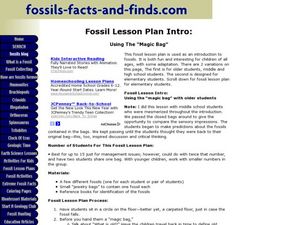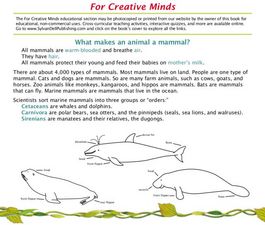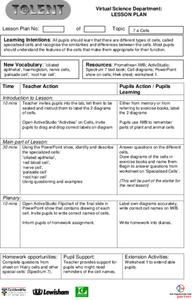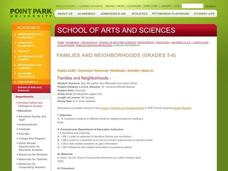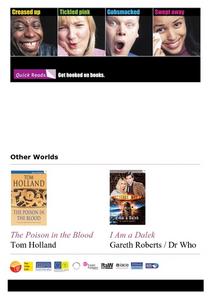Curated OER
Putting It on the Map
Young scholars consider the purpose of various types of maps and their different uses throughout history. They create their own maps and reflect on the map-making process.
Curated OER
Dictionary Details
This clever lesson has students practice finding a variety of types of information in a dictionary by playing a "Dictionary Scavenger Hunt" game. Students must use the guide words at the top of a dictionary page, determine what part of...
Curated OER
Fossil Facts and Finds- Using the Magic Bag
Students investigate fossils. In this geology instructional activity, students study various types of fossils in rocks and identify the characteristics of the fossil. Students write a research paper on their fossil.
Curated OER
Optical Illusions
Students view, identify, and construct four optical illusions. In this optical illusions lesson plan, students are introduced to four types of optical illusions. They construct their own illusions.
Curated OER
Do You Haiku? We Do!
Third graders try their hands at writing Haiku, a form of Japanese poetry. Haiku is usually 17 syllables in three-line form. This engaging lesson has many excellent worksheets and website imbedded in the plan. They share their finished...
Curated OER
Sequence of Events Practice 7-Rock Layers
In this rock layers learning exercise, students are given a diagram of rock layers each labeled with a letter. Students identify 18 events in sequential order that occurred to form the layers. They label each type of rock using the...
Curated OER
Year Book Page Special Shape Collage
Students design a collage of pictures for a yearbook that make a shape. They determine the area of the shape and the price of putting the collage in the yearbook.
Curated OER
Easy to Read
Students compare reading passages in paragraph form to book form. They determine that the reading passages on the state assessments are no more difficult than the books they choose to read. They turn their favorite books into reading...
Curated OER
Enrichment Activities - "Mrs. Frisby and the Rats of NIMH"
Fifth graders read the novel "Mrs. Frisby and the Rats of NIMH." They discuss the various characters in the book, and the different types of conflict that take place within the book. They also research owls and rats to make comparisons...
Curated OER
Gee's Bend Quilts
Third graders identify five new facts about the quilts, women, and community of Gee's Bend and finish their quilts by sewing the four edges of the quilt down. They review the color wheel and what the terms Primary, Secondary, Analogous,...
Curated OER
A Speech for the Sneetches
Students write a speech using Dr. King as an example and the characters from a Dr. Seuss book. In this speech lesson, students read the 'I Have a Dream' speech and use it as a guide to help them write a speech based on the book Sneetches...
Curated OER
Gee's Bend Quilts Two
Third graders identify the different types of lines. They name five new facts about the quilts studied, the women, and community of Gee's Bend and begin to stitch the pieces of the Quilt top together. When finished student put all their...
Curated OER
Fahrenheit 451: Social Criticism
Learners write a four paragraph essay that tells about two things in society that Ray Bradbury criticizes in the book, Fahrenheit 451. For this social criticism lesson, students develop a thesis based on their reading of the book and...
Curated OER
For Creative Minds: What Makes an Animal a Mammal?
Students read about categories of mammals and their features. Students then construct a marine animal, using given print outs in the lesson. Students then create adaptations for their mammal, using a web site reference for guidance.
Curated OER
On Market Street
Second graders study basic facts about consumers and consumer goods. The book "On Market Street" is used in this instructional activity.
Curated OER
Cells
Learners explore the types of cells and their appropriate function. After observing a PowerPoint presentation, students draw diagrams of cells. Using a specified website, learners identify parts of plant and animal cells. They answer...
Curated OER
The Clouds Tell All
Students examine the different types of clouds and how they form. They are to create their own weather forecast based on their observations of clouds in their area. Questions are asked for comprehension to end the lesson.
Curated OER
Mr.Bubble's News
Second graders use a double bubble thinking map to compare newspapers and magazines. They browse through magazines and newspapers to identify characteristics of each type of text and find 5 features for each type of text. They share...
Curated OER
Families and Neighborhoods
Students answer questions about families and what they do together. Students discuss different types of families and draw a picture of their family, discussing similarities and differences in the pictures and in families in general.
Curated OER
What Is Haiku
Students engage in a lesson that is concerned with the study of poetry while focusing on Haiku as a format. They practice reading a variety of different pieces of literature in order to increase exposure. Students discuss the author's...
Curated OER
Other Worlds
Students explore the variety of 'other worlds' in fiction and their uses in reflecting our own. They explore the role of myth and
legend as the basis for modern story telling. Book extracts are provide for classroom use.
Curated OER
Rainforests: What Are They?
Second graders investigate rain forests by reading a habitat checklist. In this environment lesson, 2nd graders read the book The Great Kapok Tree, and discuss what characteristics make up a rain forest. Students explore a habitat...
Curated OER
Letters from Rifka
Students read Karen Hesse's book "Letters from Rifka" and explore how it presents the experiences of a Russian immigrant to America. They research and write reports on the experiences of various immigrants from different cultures, keep...




